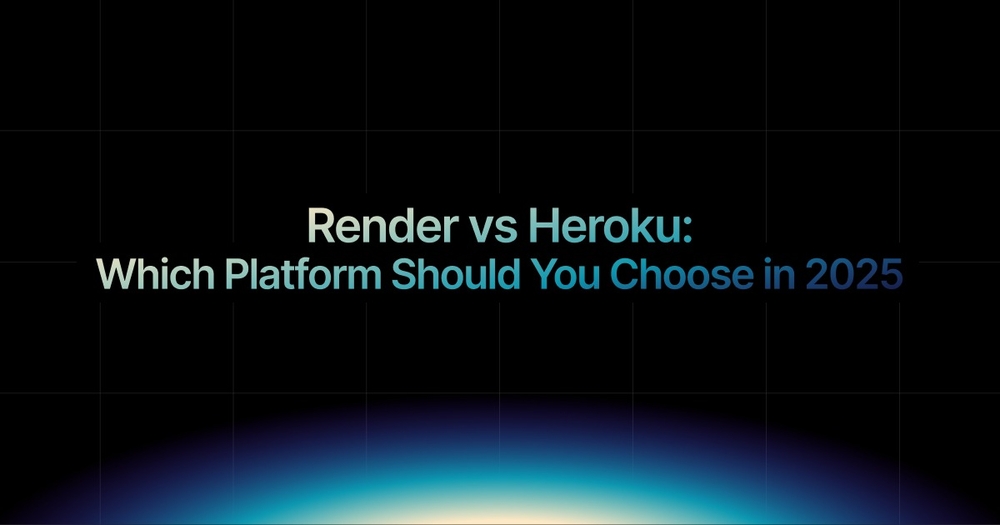Published
- 4 min read
Render vs Heroku: Which Platform Should You Choose in 2025?

Platforms like Heroku and Render have long promised developers a simpler way to deploy and scale applications without diving into infrastructure management.
But in 2025, as developer needs evolve, cost pressure increases, and YAML fatigue reaches its peak, the question isn’t just Heroku or Render anymore.
Is there a better alternative altogether?
In this article, we’ll provide a comprehensive comparison of Render vs Heroku from timeouts and configurations to pricing and performance.
And if you are looking for free Heroku alternative in 2025, this guide will help you.
Quick Overview
Heroku: The Original PaaS Pioneer
Launched in 2007, Heroku made waves by abstracting away infrastructure, letting developers deploy apps with a simple git push heroku main.
While it defined the PaaS category, Heroku has been relatively stagnant in recent years.
Pricing changes (like the removal of the free tier) and outdated limits (like 30-second request timeouts) have pushed many developers to look elsewhere.
Render: The Modern Challenger
Render launched to offer a more modern take on Heroku. With longer timeouts, persistent disks, and built-in support for background jobs and cron, it quickly gained traction among teams needing more flexibility.
But as it has matured, some developers find that Render still requires a fair bit of configuration, including YAML-based deploy files and occasional CLI work.
Feature Comparison
We examine critical platform features and how Render and Heroku differ. The table below summarises the core contrasts.
| Feature | Render | Heroku |
|---|---|---|
| Request Timeouts | Up to 100 minutes per HTTP request (configurable). Ideal for long jobs directly. | 30-second hard limit on HTTP responses. Long tasks must use background jobs. |
| Developer Config | Flexible build scripts (render.yaml) and Docker images. More manual configuration but finer control. | Convention-over-configuration via Buildpacks. Easier startup with defaults (less YAML). |
| Background Workers | Native background worker services (scaled separately) and job queues. Built-in support for jobs. | Requires separate dynos for workers (incurs extra cost). |
| Scheduled Jobs | Full-featured cron jobs (any schedule or frequency). | Scheduler add-on limited to fixed intervals (every 10 minutes, hour, or day). |
| Persistent Storage | Offers persistent “disks” (block storage) to retain files across deploys; supports stateful services (DB, search, etc.). | Ephemeral filesystem on dynos – all local files are lost on deploy/restart; relies on add-ons for persistence. |
| Rollbacks & Deploys | One-click rollback to a previous deploy. Can reuse build artifacts so rollbacks are quick. Zero-downtime deploys by default (no forced restarts). | CLI releases: heroku rollback reverts to a previous release in one command. Deploys cause forced restarts and may incur brief downtime (Heroku dynos restart every 24h). |
| Performance / Uptime | No scheduled restarts (no 24h reboot), built-in health checks. | Dynos restart daily (losing in-memory caches and websockets). Historic outages have impacted reliability. |
| Pricing (2GB RAM) | $25/mo for a 2GB web service (clear, low pricing). | ~$250/mo for a comparable dyno (2.5GB RAM). Costs rise quickly with scale. |
| Free Tier | Generous free tier for hobby projects (limited hours/resources) with easy upgrades. | No free dynos (free tier ended in 2022). Must use paid dynos for any non-trivial workload. |
But what if you want more control, lower costs & no YAML?
While Heroku and Render serve specific types of teams, many developers today want something more:
- The ease of git push, but without constraints like timeouts or dyno limits.
- The performance of container-based infrastructure without writing Dockerfiles or YAML.
- Cost clarity without surprise bandwidth or add-on charges.
That’s why we built Kuberns for developers of 2025.

Kuberns is an emerging AI-powered PaaS built to bridge the gap. Kuberns bills itself as an “AI-powered cloud autopilot for one-click deployments”. It aims to combine Heroku’s ease-of-use with the flexibility and pricing predictability of modern platforms.
Kuberns uses AI to automate your infrastructure decisions. Whether you’re running a simple Flask app or a complex ML model, it:
- Deploys from Git with zero YAML configuration
- Monitors performance and triggers automatic rollback
- Offers up to 40% lower cloud bills using its own optimised AWS infrastructure
- Supports background jobs, cron tasks, and persistent storage
And all of this happens through a single dashboard.

Check out how Kuberns is better than Heroku and Render
Why teams are switching to Kuberns?
Here’s what one startup CTO told us after migrating from Heroku:
“We were hitting Heroku’s limits every week. Long-running APIs would just timeout, and logs were painful to trace. We switched to Kuberns and instantly got persistent jobs, AI-managed deploys, and better cost control. Honestly, we haven’t looked back.”
Kuberns is especially loved by:
- Fast-moving startups are tired of paying per-user or per-dyno fees
- Solo developers building apps without wanting to touch Dockerfiles
- Mid-sized teams that need rollback and uptime but don’t have full-time DevOps
Final Comparison: Render vs Heroku
Render and Heroku both made app deployment easier in their own way.
But in 2025, the bar is higher.
Developers want Faster performance, Greater flexibility, Better cost transparency, Minimal configuration and less DevOps overhead.
Kuberns delivers on all fronts.
It takes what Heroku and Render started and levels it up using automation, AI, and developer-first design.
If you’re tired of YAML, slow deploys, unclear pricing, or broken rollback plans, it might be time to switch.
👉 Deploy your app with zero YAML, full rollback, and 40% lower cloud spend